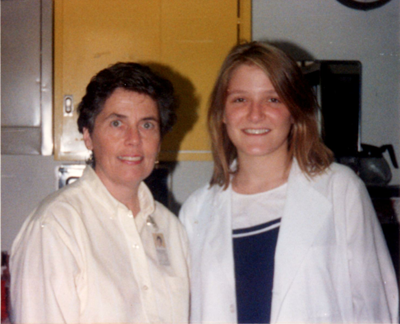Updates from the Field: Why Did I Love Science as a Kid?
This is a guest post from Saskia Traill, Vice President for Policy and Research at The After School Corporation (TASC), with contributions from CAISE project director Jamie Bell. The original post was published on Saskia's blog at the TASC site.

#ThrowbackSTEMDay: The author, right, dons a crisp lab coat as an eager young hospital volunteer.
What are the building blocks of an education that might seed a child's passion for science, technology, engineering, math, or all of the above? While attending a recent meeting hosted by the National Research Council and the STEM Funders Network, I found it useful to think about what made me spark to those subjects when I was young. There was my terrific 6th grade science teacher, Mr. Shank; a robust science fair at my middle school; an engaging 9th grade biology teacher, Ms. Thompson; a Saturday class on perception that I attended at a local college; my encouraging parents; and a volunteer gig on a hospital ward.
It's hard to know where one STEM learning "sector" ended and another began. For a child, the world isn't carved into programs, systems, or funding streams. It's a series of moments that build on one another to offer a deeper understanding of science and its place in the world-or not, if a child never has a chance to make those connections.
That's the discussion that brought together a diverse group of science teachers, after-school providers, funders, researchers, science center leaders, and "backbone" organizations like ExpandEDSchools, Boston After School & Beyond, the Indiana Afterschool Network, and others at this meeting. Building on a report the Noyce Foundation commissioned, we discussed how to build an "ecosystem" of connections between homes, schools, science-rich institutions, and youth-serving organizations to better link young people's STEM learning experiences. To make progress, we need to:
- Agree on shared visions and outcomes that encompass multiple settings. Not just better school performance, after-school engagement or more informal science education opportunities, but also a broader view of supporting kids’ healthy social, emotional, and cognitive development.
- Fund intermediary and other “backbone” organizations that intentionally look for and build partnerships.
- Construct and deliver joint professional development for teachers and community educators so that they build trust, a common language, shared curricula, and systems for communicating day-to-day.
- Continue to build the field of like-minded colleagues around the country who are striving towards this vision.
Look for a report on these “STEM Learning is Everywhere” discussions to come shortly from the National Research Council.